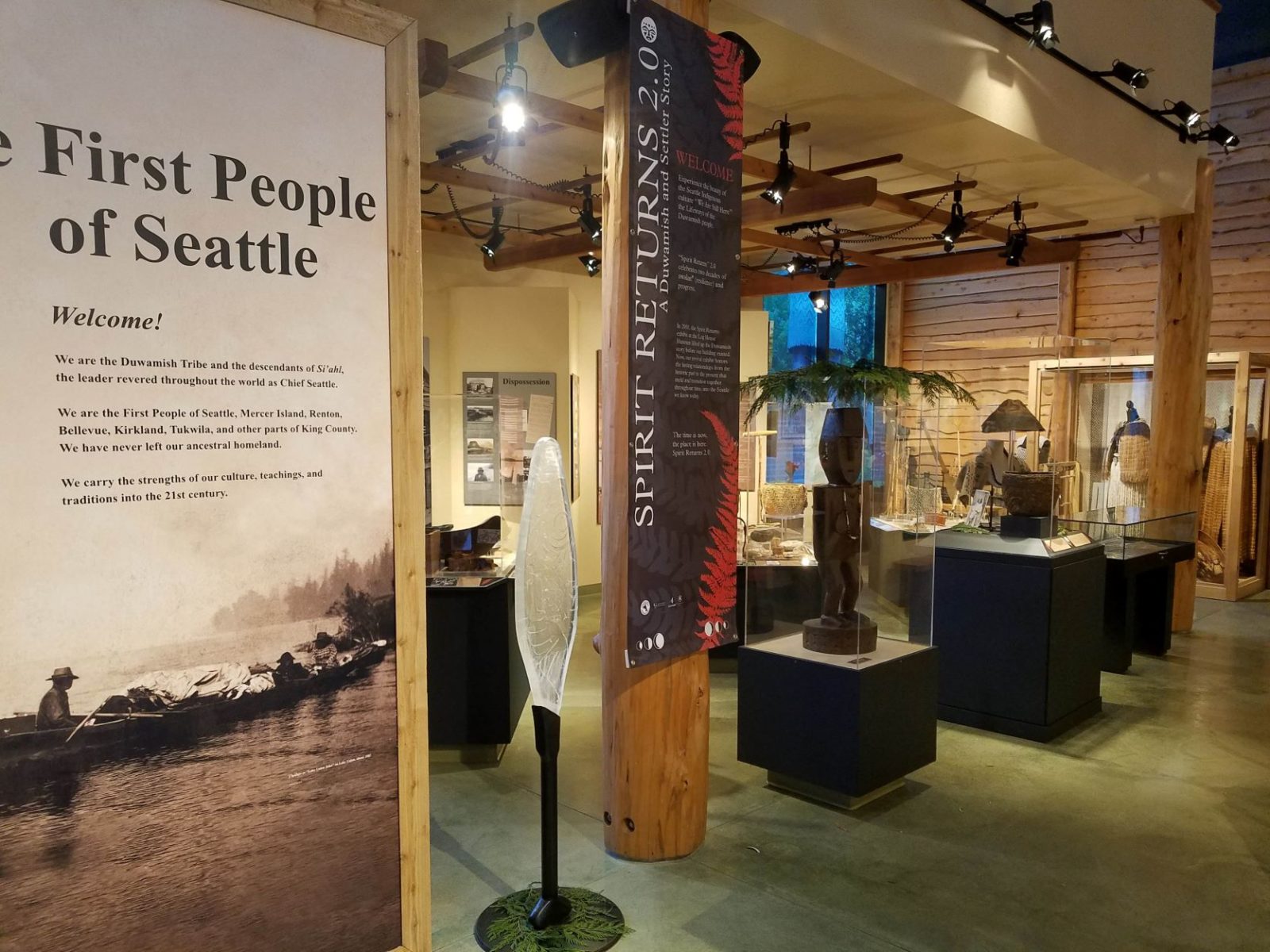Guest Post: Exhibit Reimagined 20 Years Later

In this joint post, curators Maggie Kase at the Log House Museum and Heidi Bohan from the Duwamish Longhouse and Cultural Center share the history behind the new exhibit The Spirit Returns 2.0: A Duwamish and Settler Story, which was supported by 4Culture grants:
The Spirit Returns 2.0: A Duwamish and Settler Story is a collaborative exhibit between the Duwamish Longhouse and Cultural Center and the Southwest Seattle Historical Society. The Spirit Returns 2.0: A Duwamish and Settler Story celebrates two decades of growth and progress. Collectively, we explore the authentic stories of the complex relationships of trade, managed and natural resources, social hierarchy, and the growing relationships between the Duwamish and non-native settlers who arrived in the 1850’s and together melded and transitioned into the Seattle we know today.
Together, we revisited and updated The Spirit Returns: A Duwamish and Pioneer Story which was hosted at the historical society’s Log House Museum in 2001. One of the biggest changes between the 2001 and 2021 iterations of the exhibit is the fact that Spirit Returns 2.0 is hosted in two locations: the Duwamish Longhouse and Cultural Center, and the Southwest Seattle Historical Society’s Log House Museum. The initial decision to revisit the exhibit happened in 2019, but most of the collaboration process occurred in 2020 and 2021 via Zoom.
At the Log House Museum, visitors will find an exhibit that explores the stories of key non-native settlers, and their early relationships with each other and with the Duwamish Tribe to set the stage for a celebration of contemporary collaborations and friendship between these communities. We examine a range of topics from why settlers wanted to move west in the first place, to how their arrival in the Seattle area changed pre-existing relationships with the Duwamish Tribe. Ultimately, Spirit Returns 2.0 ends on a note of growth, showcasing the progress that has been made in the 20 years since the first exhibit at the Log House Museum.
At the Longhouse we approached this exhibit from the perspective of what has now “returned” since the 2001 exhibit. The Duwamish Tribe now has a beautiful new longhouse constructed at an old village site along one of the only natural curves in the Duwamish River. We use the knowledge contained within the artifacts found at this village site as well as known place names nearby, as the basis to help tell the story of the lifeways of the Duwamish people past and present. The Tribe can now tell their own story in their own exhibit at the entrance to their own Longhouse, with objects ancient and new—many now returned to tribal ownership, others under their care.
As curators for these two very different, yet linked, exhibits we worked hard to listen and learn from those involved in the first exhibit, and, to what our leadership wanted to have told with this new exhibit. The words we heard again and again were “uplifting,” “celebratory,” “love,” “return.” Because this is a dual-hosted exhibit, one of the most important aspects we had to consider were the touchpoints between the two spaces that would make them feel like one project rather than two exhibits with the same name. What themes were we both exploring? How do our stories intersect? We spent many meetings discussing the nuances of language and approach, words such as “pioneer,” “party,” “industrious,” “first contact.” Pushing back against that language became one of the key ways we blended our stories together.
Finding those thematic overlaps was a great starting point. We expanded on connecting the exhibits as well through the loaning of collections objects between our organizations, and the graphic design and marketing materials for the exhibit. By showcasing artifacts from the other half of the exhibit at both locations, we were able to create clear connections and call-outs between both institutions. Using the same marketing materials and graphic direction overall was another way we were able to make the physical experience of the exhibit feel seamless and interconnected in both spaces.
Underlying this story is the lasting friendship between the Log House Museum and the Duwamish Longhouse, also represented in other community collaborations such as the Real Rent program which supports the Duwamish Tribe.
We are still planning joint school tours and public programs, virtual or in-person. The Longhouse exhibit is ongoing, and will continue to be expanded while the Log House Museum will close their exhibit April 17, 2022. See the two exhibits at the9 Duwamish Longhouse and Cultural Center and Log House Museum today!
